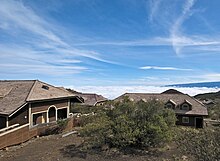Onizuka Center for International Astronomy
A few rustic cabins named Hale Pōhaku (which means "stone house" in the Hawaiian language[1]) were built by the Civilian Conservation Corps on the southern slope of Mauna Kea in the 1930s for hunters and other explorers.
[2] A rough jeep trail was built in 1964 under Governor John A. Burns, and a small telescope determined that Mauna Kea would be an ideal place for an astronomical observatory.
The center consists of dormitories with sleeping accommodation for 72, as well as a main building which houses the shared facilities such as cafeteria, laundry, and common room.
[6] W. M. Keck Observatory reported 90% of observations were remote by 2002, many from their facility in Waimea, on the plateau north of the mountain, and automation allowed control from California.
The VIS houses informational displays, and shows videos depicting the history and work of the observatories, as well as the geology, ecology and cultural significance of Mauna Kea.
As of 2010[update], visitors wishing to continue on the steep and twisting gravel road to the summit are strongly recommended to bring four wheel drive vehicles with well-maintained brakes.



